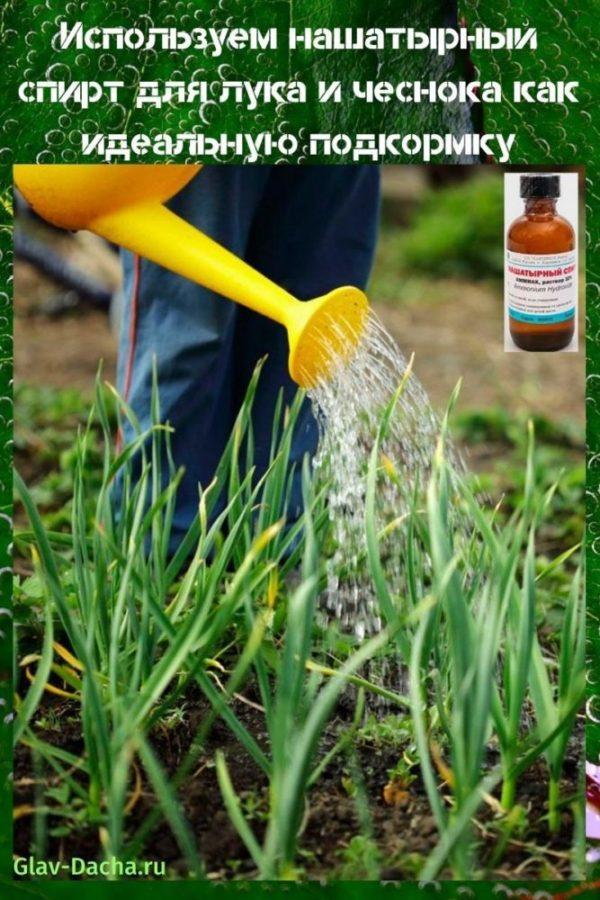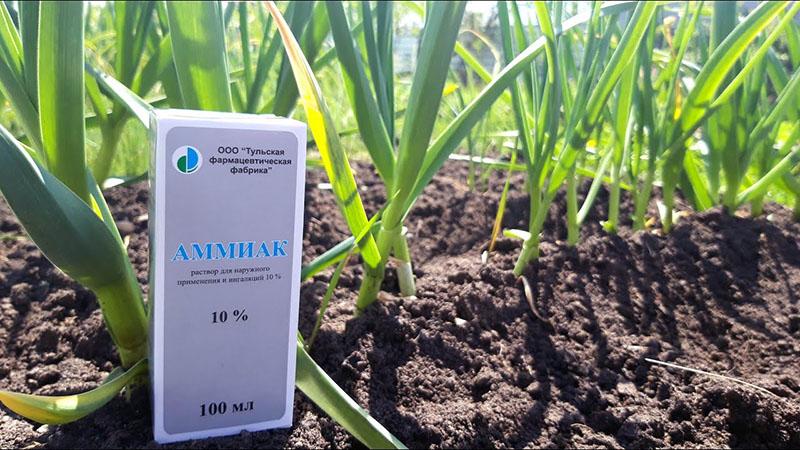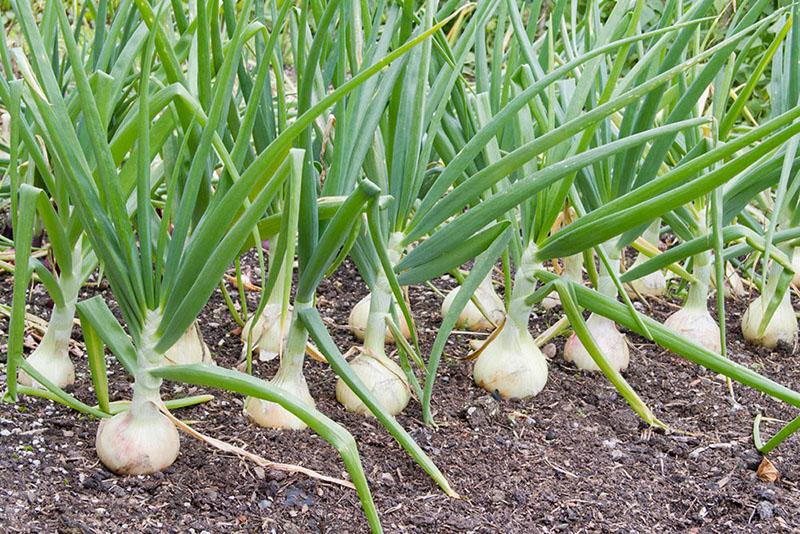We use ammonia for onions and garlic as an ideal top dressing
 Like all vegetables grown in the country, natural antibiotics also need an additional dose of ammonia. To solve the problem, gardeners use pharmacy ammonia for onions and garlic as an excellent fertilizer. After all, the growth and development of plants directly depends on a sufficient amount of nutrients. For example, carbohydrates are produced by photosynthesis, which uses water, light, carbon dioxide and chlorophyll. All the onion and garlic components are obtained from the atmosphere. Nitrogen is absorbed from the air only by legumes. Therefore, gardeners have come up with a cheap way of perfect nitrogen feeding.
Like all vegetables grown in the country, natural antibiotics also need an additional dose of ammonia. To solve the problem, gardeners use pharmacy ammonia for onions and garlic as an excellent fertilizer. After all, the growth and development of plants directly depends on a sufficient amount of nutrients. For example, carbohydrates are produced by photosynthesis, which uses water, light, carbon dioxide and chlorophyll. All the onion and garlic components are obtained from the atmosphere. Nitrogen is absorbed from the air only by legumes. Therefore, gardeners have come up with a cheap way of perfect nitrogen feeding.
From one field of "berries"


The reason is the peculiarities of the structure of plants:
- thin weak root system;
- roots, fruit, stem smoothly turn into foliage;
- the interconnection of all parts of the culture (one gets sick, everyone suffers).
 For vegetables to be able to absorb nutrients from the soil, they should not be too deep.
For vegetables to be able to absorb nutrients from the soil, they should not be too deep.
If plants are experiencing, nitrogen deficiency is determined by a number of signs:
- the plates take on a pale green color;
- yellow spots appear on the foliage;
- redness of the tips is observed;
- the drying process is gradually going on;
- the underground part stops growing;
- the heads start to rot.
Quality feeding saves crops. Of course, you can add carbamide or urea. However, even the smallest violation of the dose usually leads to disaster. We will find out the most optimal variant of a unique fertilizer, which costs "a penny".
Pharmacy ammonia for onions and garlic
 When a person loses consciousness, the ammonia solution returns him to reality. In a similar way, the pharmaceutical substance has a beneficial effect on "natural antibiotics". Crops respond wonderfully to original fertilization. Using ammonia for onions and garlic, summer residents notice a noticeable growth of the ground part of the plants. In addition, the substance stimulates the accumulation of chlorophyll in the tissues, which strengthens the defenses of vegetables.
When a person loses consciousness, the ammonia solution returns him to reality. In a similar way, the pharmaceutical substance has a beneficial effect on "natural antibiotics". Crops respond wonderfully to original fertilization. Using ammonia for onions and garlic, summer residents notice a noticeable growth of the ground part of the plants. In addition, the substance stimulates the accumulation of chlorophyll in the tissues, which strengthens the defenses of vegetables.
Fertilizer is applied directly to the soil, and not sprayed on the bushes. As a result, the assimilation process is much faster.
 The correct dose of the substance promotes the formation of large heads of spicy crops. For the first time, the soil is fed with a highly concentrated solution. For 1 liter of warm water add 1 tablespoon of pharmacy ammonia and mix thoroughly. Then additional holes are made between the rows. The resulting liquid is poured and sprinkled with earth on top. To prevent ammonia from escaping, after 2 days, the aisles are carefully loosened and thoroughly moistened. Poor soil is enriched with a simple solution. 50-60 ml of the substance is poured into 10 liters of water, mixed and the beds are watered. Thanks to feeding with ammonia, garlic and onions develop successfully throughout the season.
The correct dose of the substance promotes the formation of large heads of spicy crops. For the first time, the soil is fed with a highly concentrated solution. For 1 liter of warm water add 1 tablespoon of pharmacy ammonia and mix thoroughly. Then additional holes are made between the rows. The resulting liquid is poured and sprinkled with earth on top. To prevent ammonia from escaping, after 2 days, the aisles are carefully loosened and thoroughly moistened. Poor soil is enriched with a simple solution. 50-60 ml of the substance is poured into 10 liters of water, mixed and the beds are watered. Thanks to feeding with ammonia, garlic and onions develop successfully throughout the season.
Consumption of the working solution of ammonia fertilizer is 10 liters per 2 m² of vegetable planting.
Variants of preparation and use of the substance

Winter varieties of garlic They feed in mid-April when the air temperature is around 10-15 ° C. Usually at this time 2-3 young leaf plates already appear on the surface. The next soil treatment is carried out in the presence of symptoms indicating a lack of nitrogen.
 Spring garlic is sprayed directly upon planting. The heads are divided into teeth and poured with a solution of ammonia. After the appearance of greenery (5-6 leaves), re-feeding is carried out. Further, throughout the season, the culture is treated every 14 days. To prepare an ammonia solution, you need 10 liters of water and 2 tablespoons of ammonia. The liquid is thoroughly mixed and used for watering the soil or processing feathers. Creating a preventive feeding, 3 tablespoons of ammonia are poured into a bucket of water. The same concentration of the substance is made at the first signs of yellowing of plant foliage.
Spring garlic is sprayed directly upon planting. The heads are divided into teeth and poured with a solution of ammonia. After the appearance of greenery (5-6 leaves), re-feeding is carried out. Further, throughout the season, the culture is treated every 14 days. To prepare an ammonia solution, you need 10 liters of water and 2 tablespoons of ammonia. The liquid is thoroughly mixed and used for watering the soil or processing feathers. Creating a preventive feeding, 3 tablespoons of ammonia are poured into a bucket of water. The same concentration of the substance is made at the first signs of yellowing of plant foliage.
The natural ripening of garlic is also indicated by yellowed feathers. No fertilization is needed during this period.
 To increase the yield of onions, they are also fed with diluted ammonia. Depending on the purpose of growing the culture, a different dosage is used:
To increase the yield of onions, they are also fed with diluted ammonia. Depending on the purpose of growing the culture, a different dosage is used:
- for greens, for 10 liters of warm water, 0.5 tablespoon of alcohol is enough;
- when yellowness appears on the feathers, 45 ml of the substance is poured into the same volume of liquid;
- for prevention purposes, the plant is treated with a solution obtained from 10 liters of water and 3 tablespoons of alcohol.
 The first time the culture is treated when the feathers reach 10 cm in height. In addition, it is important to know how to dilute ammonia for watering onions in order to fertilize the soil. The yield of the underground part of the crop depends on the correct dosage. Usually, 15 ml of ammonia is poured into a bucket of water. The jet is directed directly to the ground, trying not to touch the foliage. The procedure is carried out in the late evening or in the morning, when the sun is low over the horizon and there is no wind.
The first time the culture is treated when the feathers reach 10 cm in height. In addition, it is important to know how to dilute ammonia for watering onions in order to fertilize the soil. The yield of the underground part of the crop depends on the correct dosage. Usually, 15 ml of ammonia is poured into a bucket of water. The jet is directed directly to the ground, trying not to touch the foliage. The procedure is carried out in the late evening or in the morning, when the sun is low over the horizon and there is no wind.
When working with the substance, it is advisable to wear a respirator and rubber gloves.
Original pest control
 The unpleasant smell of ammonia scares away various insects that want to settle in a cozy garden.
The unpleasant smell of ammonia scares away various insects that want to settle in a cozy garden.
Most often, onions and garlic strike:
- wireworm;
- onion fly;
- root nematode;
- secretive proboscis;
- aphid.
 Usually, plants are cultivated only after finding insects that are ready to destroy a valuable crop. For the procedure, you need a watering can with large cells, which is filled with an ammonia solution. The processing of garlic and watering the onion with ammonia is carried out according to the generally accepted scheme. "Insecticide" is prepared according to the recipe: 50 ml of pharmacy ammonia is poured into 10 liters of water. Add 50 g of crushed laundry soap and mix the resulting substance thoroughly.
Usually, plants are cultivated only after finding insects that are ready to destroy a valuable crop. For the procedure, you need a watering can with large cells, which is filled with an ammonia solution. The processing of garlic and watering the onion with ammonia is carried out according to the generally accepted scheme. "Insecticide" is prepared according to the recipe: 50 ml of pharmacy ammonia is poured into 10 liters of water. Add 50 g of crushed laundry soap and mix the resulting substance thoroughly.
The soap solution is prepared in advance. Chips are added to a jar of warm water and infused for 12 hours. During this time, a homogeneous mass is formed in the container. The soapy environment traps ammonia molecules on plant feathers and soil surfaces.
To combat the onion fly, a special “explosive mixture” is prepared. Ammonium (5 ml) is poured into a container with water (10 l), table salt without additives (250 g) is added. Mix thoroughly and spray the feathers of the plant. After 40 minutes, the entire garden is moistened abundantly. After 10 days, the procedure is repeated. The wireworm is destroyed with a solution prepared from 10 liters of water mixed with 10 ml of ammonia. The substance is generously sprayed with the ground part of the onion or garlic every 3 days for 2 weeks.
 In mid-May, the culture is struck by the hidden proboscis. An "insecticide" made from 25 ml of ammonia and a bucket of warm water will help get rid of it. The solution is poured over the beds 1 time per 7 days. A simple remedy will help get rid of the root nematode. In 10 liters of pure water at room temperature add 40 ml of ammonia and 3 drops of pharmaceutical iodine. The mixture is used to treat the root area of plants 2 times a month at intervals of 10 days.
In mid-May, the culture is struck by the hidden proboscis. An "insecticide" made from 25 ml of ammonia and a bucket of warm water will help get rid of it. The solution is poured over the beds 1 time per 7 days. A simple remedy will help get rid of the root nematode. In 10 liters of pure water at room temperature add 40 ml of ammonia and 3 drops of pharmaceutical iodine. The mixture is used to treat the root area of plants 2 times a month at intervals of 10 days.
It is advisable not to use finely dispersed devices, since the solution exudes poisonous vapors.
As you can see, experienced summer residents have long been using ammonia for garlic and onions as top dressing and pest control. Solutions are prepared according to strict recipes, taking into account the purpose of processing.